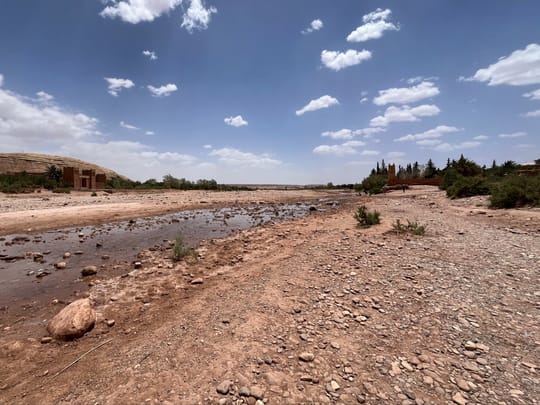Water is necessary for life. This is a simple fact that most people learn in primary school and inherently know long before that. It is literally a life-giving substance. But in the Moroccan landscape, there is a distinct lack of this essential chemical compound. This is not a byproduct of the ever-present Orientalist stereotype about the desert but rather a direct result of climate change and the increasingly severe droughts which this international phenomenon is bringing. There are doubtless countless studies and a plethora of scientific facts to describe the drought which dominates the landscape and which has indelibly shaped the livelihoods of Moroccans. But ultimately what I have found to be more poignant is simple observation.
It is not just that the landscape is dry, nor is it just that it is devoid of the vegetation one might expect further north in Morocco. Rather, what becomes clear in driving in the expansive and diverse region between Khenifra and Azilal and Tiznit is that the inhabitants of this land are being forced into a fundamental shift in their livelihoods, a shift which demands increasingly resilient plants that thrive in desert-like conditions and require very little water. What becomes clear is that the livelihood that is being so fundamentally altered by these increasingly dire conditions is, in fact, not entirely a livelihood that is endemic to Morocco but is instead a livelihood which is implicitly connected to the rise of cash crop agriculture and the intrusion of capitalism and commercialism into this nation. And it is all the result of environmental trends which have conspired to target regions like Morocco which are exceptionally dependent upon unsustainable structures imposed by “expert” outsiders.
Morocco has a long tradition of widely diverse agriculture, a tradition which emphasizes and applauds biodiversity and the diversification of profit sources. For example, Amina, HAF’s tree planting program director, explained that her father and his family have long planted a huge array of crops ranging from grains such as barley and wheat to fruits such as fig and nuts such as walnuts all in addition to raising some livestock. However, many Moroccan farmers within the past few decades moved away from this endemic agricultural lifestyle and embraced cash crops. Wheat, barely, alfalfa — all crops which are associated with the recent rise of cash crop agriculture — are no longer sustainable or even remotely profitable in many regions because there is simply not enough water to support these crops. So these farmers are having to re-embrace the sort of biodiversity which encapsulates more tree-based agriculture and specifically trees that are exceptionally resilient and that, in their mature form, require less water than traditional cash crops.
And yet even with this newfound agricultural shift, the landscape in many places is still so strikingly barren. There are the trees which are supposed to be the future of Morocco, but they have long since died from a lack of water. There are fields and fields of untapped land because there is no nearby water source. And even where there is green and growth, this outward appearance often obscures the daily struggle to find sufficient amounts of water. It seems, sometimes in my very limited experience, that it is not just cash crops which are becoming increasingly obsolete in a changing environment, but that sometimes farming itself is becoming impossible. But this quite literally cannot be the future for which we settle because a lack of one life-giving substance — water — is endangering another life-giving substance — food.
And while agriculture is perhaps a potent example of the water shortage, it is by no means the only example. Consider that the cost of sheep for Eid has gone up by nearly 1,000 dirham across much of the nation. For me, this is perhaps the truly striking nature of the water shortage — this shortage has touched every aspect of Moroccan life, from the work that is done to religious traditions. It is easy to take for granted substances like water which are so basic in our ability to survive. It is so easy to start forgetting how these “guarantees” have shaped the way we live and with what assumptions we approach life. But when they begin to be taken away, as in Morocco, what is left, hopefully, is not the remnants of a culture but rather a clear and contemporary picture of how cultures adapt.
